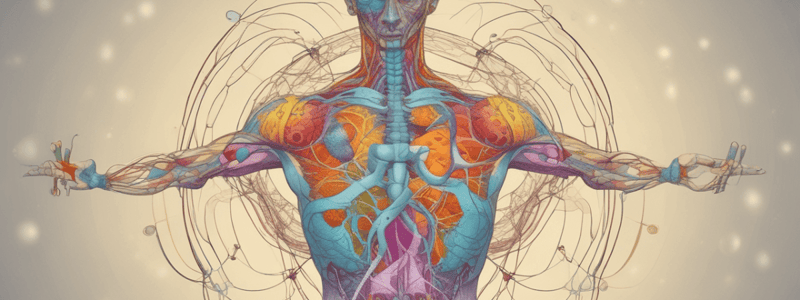Podcast
Questions and Answers
Buffer systems in the human body maintain a radical change in fluid pH by capturing free ions.
Buffer systems in the human body maintain a radical change in fluid pH by capturing free ions.
False (B)
Weak acids and weak bases are rarely used as buffers in the human body.
Weak acids and weak bases are rarely used as buffers in the human body.
False (B)
Protein buffers account for the majority of the buffering power within cells.
Protein buffers account for the majority of the buffering power within cells.
True (A)
Hemoglobin has no role in maintaining acid-base balance in the human body.
Hemoglobin has no role in maintaining acid-base balance in the human body.
The human body uses only one type of buffer system to maintain acid-base balance.
The human body uses only one type of buffer system to maintain acid-base balance.
Buffer systems work by releasing free ions and allowing significant changes in pH.
Buffer systems work by releasing free ions and allowing significant changes in pH.
The bicarbonate-carbonic acid buffer system is found only in the lungs.
The bicarbonate-carbonic acid buffer system is found only in the lungs.
Phosphate buffers are found in the blood in only one form.
Phosphate buffers are found in the blood in only one form.
When Na2HPO42− comes into contact with a strong acid, it forms a strong acid and sodium chloride.
When Na2HPO42− comes into contact with a strong acid, it forms a strong acid and sodium chloride.
The bicarbonate-carbonic acid buffer system helps to maintain acid-base balance in the human body.
The bicarbonate-carbonic acid buffer system helps to maintain acid-base balance in the human body.
Buffer systems are only found in the blood.
Buffer systems are only found in the blood.
Hemoglobin acts as a buffer by releasing hydrogen ions.
Hemoglobin acts as a buffer by releasing hydrogen ions.
Respiratory acidosis occurs when the lungs eliminate too much carbon dioxide, leading to a decrease in pH.
Respiratory acidosis occurs when the lungs eliminate too much carbon dioxide, leading to a decrease in pH.
Alveolar hypoventilation is a primary cause of chronic respiratory acidosis.
Alveolar hypoventilation is a primary cause of chronic respiratory acidosis.
Carbonic acid is formed by the combination of oxygen and water in the bloodstream.
Carbonic acid is formed by the combination of oxygen and water in the bloodstream.
The bicarbonate ion helps to increase the pH of the blood by neutralizing hydrogen ions.
The bicarbonate ion helps to increase the pH of the blood by neutralizing hydrogen ions.
Respiratory acidosis is typically characterized by an increase in pH levels in the blood.
Respiratory acidosis is typically characterized by an increase in pH levels in the blood.
Chronic respiratory acidosis is typically caused by sudden failure of ventilation.
Chronic respiratory acidosis is typically caused by sudden failure of ventilation.
In respiratory acidosis, the arterial blood gas (ABG) typically shows a decreased partial pressure of arterial carbon dioxide (PaCO2)
In respiratory acidosis, the arterial blood gas (ABG) typically shows a decreased partial pressure of arterial carbon dioxide (PaCO2)
Mild cases of respiratory acidosis often present with symptoms such as altered mental status, myoclonus, and seizures
Mild cases of respiratory acidosis often present with symptoms such as altered mental status, myoclonus, and seizures
The bicarbonate ion's buffering capacity is always exceeded in respiratory acidosis
The bicarbonate ion's buffering capacity is always exceeded in respiratory acidosis
Respiratory acidosis can be diagnosed by evaluating the patient's serum bicarbonate levels only
Respiratory acidosis can be diagnosed by evaluating the patient's serum bicarbonate levels only
Sleep disturbances are a common symptom of respiratory acidosis
Sleep disturbances are a common symptom of respiratory acidosis
The chloride shift helps to decrease the efficiency of oxygen unloading in the lungs.
The chloride shift helps to decrease the efficiency of oxygen unloading in the lungs.
The chloride shift plays a role in facilitating the transport of oxygen in the blood.
The chloride shift plays a role in facilitating the transport of oxygen in the blood.
Carbon dioxide is converted to bicarbonate by carbonic anhydrase in the lungs.
Carbon dioxide is converted to bicarbonate by carbonic anhydrase in the lungs.
The chloride shift helps to decrease the CO2-carrying capacity of the venous blood.
The chloride shift helps to decrease the CO2-carrying capacity of the venous blood.
The chloride shift is not essential for the transport of carbon dioxide in the blood.
The chloride shift is not essential for the transport of carbon dioxide in the blood.
The transport of carbon dioxide in the blood occurs through only two main mechanisms: dissolved in solution and buffered as carbonic acid.
The transport of carbon dioxide in the blood occurs through only two main mechanisms: dissolved in solution and buffered as carbonic acid.
The chloride shift decreases the CO2-carrying capacity of the venous blood.
The chloride shift decreases the CO2-carrying capacity of the venous blood.
Carbonic anhydrase is responsible for converting bicarbonate to carbon dioxide in the red blood cells.
Carbonic anhydrase is responsible for converting bicarbonate to carbon dioxide in the red blood cells.
The chloride shift helps maintain a constant pH in the peripheral circulation by mitigating the change that would otherwise occur due to metabolic byproducts.
The chloride shift helps maintain a constant pH in the peripheral circulation by mitigating the change that would otherwise occur due to metabolic byproducts.
The chloride shift occurs in the lungs, where oxygen is unloaded and carbon dioxide is loaded into the blood.
The chloride shift occurs in the lungs, where oxygen is unloaded and carbon dioxide is loaded into the blood.
The bicarbonate ion is formed in the red blood cells during the chloride shift.
The bicarbonate ion is formed in the red blood cells during the chloride shift.
Flashcards are hidden until you start studying
Study Notes
Acid-base balance is a critical aspect of maintaining homeostasis in the human body. It refers to the physiological state in which the concentration of acids and bases in bodily fluids, such as blood, is maintained within narrow ranges. This balance is essential for proper physiological functioning because it directly affects various bodily functions, such as metabolism, cellular processes, and organ function. The human body uses several buffer systems to maintain this delicate balance.
Buffer systems are chemical systems that prevent a radical change in fluid pH by dampening the change in hydrogen ion concentrations. They work by capturing free ions and preventing significant changes in pH. The most commonly used buffers are weak acids or weak bases, which absorb hydroxyl ions or hydrogen ions, respectively.
Protein Buffers
Protein buffers, such as plasma proteins, play a significant role in maintaining acid-base balance. These proteins, which include hemoglobin, are made up of amino acids, which contain positively charged amino groups and negatively charged carboxyl groups. The charged regions of these molecules can bind hydrogen and hydroxyl ions, acting as buffers. Buffering by proteins accounts for two-thirds of the buffering power of the blood and most of the buffering within cells.
Hemoglobin as a Buffer
Hemoglobin, the principal protein inside red blood cells, is a crucial buffer system that helps maintain normal pH. During the conversion of carbon dioxide into bicarbonate, hemoglobin absorbs hydrogen ions, acting as a buffer. This process is reversed in the pulmonary capillaries to re-form carbon dioxide, which then can diffuse into the air sacs to be exhaled.
Phosphate Buffer
Phosphate buffer systems are found in the blood in two forms: sodium dihydrogen phosphate (Na2H2PO4−), which is a weak acid, and sodium monohydrogen phosphate (Na2HPO42−), which is a weak base. When Na2HPO42− comes into contact with a strong acid, such as HCl, it forms the weak acid Na2H2PO4− and sodium chloride, NaCl. When Na2HPO42− (the weak acid) comes into contact with a strong base, such as NaOH, it reverts back to the weak base and produces water. Acids and bases are still present, but they hold onto the ions, preventing a significant change in pH.
Bicarbonate-Carbonic Acid Buffer
The bicarbonate-carbonic acid buffer works similarly to phosphate buffers. Sodium bicarbonate (NaHCO3), a weak base, is found in the blood. When it comes into contact with a strong acid, such as HCl, carbonic acid (H2CO3), a weak acid, and NaCl are formed. When carbonic acid comes into contact with a strong base, such as NaOH, bicarbonate and water are formed. The weak acid or weak base captures the free ions, and a significant change in pH is prevented.
In summary, buffer systems, such as protein buffers, phosphate buffers, and bicarbonate-carbonic acid buffers, play a crucial role in maintaining acid-base balance in the human body. These systems work together to ensure that the concentration of acids and bases in bodily fluids remains within narrow ranges, allowing for proper physiological functioning.
Studying That Suits You
Use AI to generate personalized quizzes and flashcards to suit your learning preferences.




